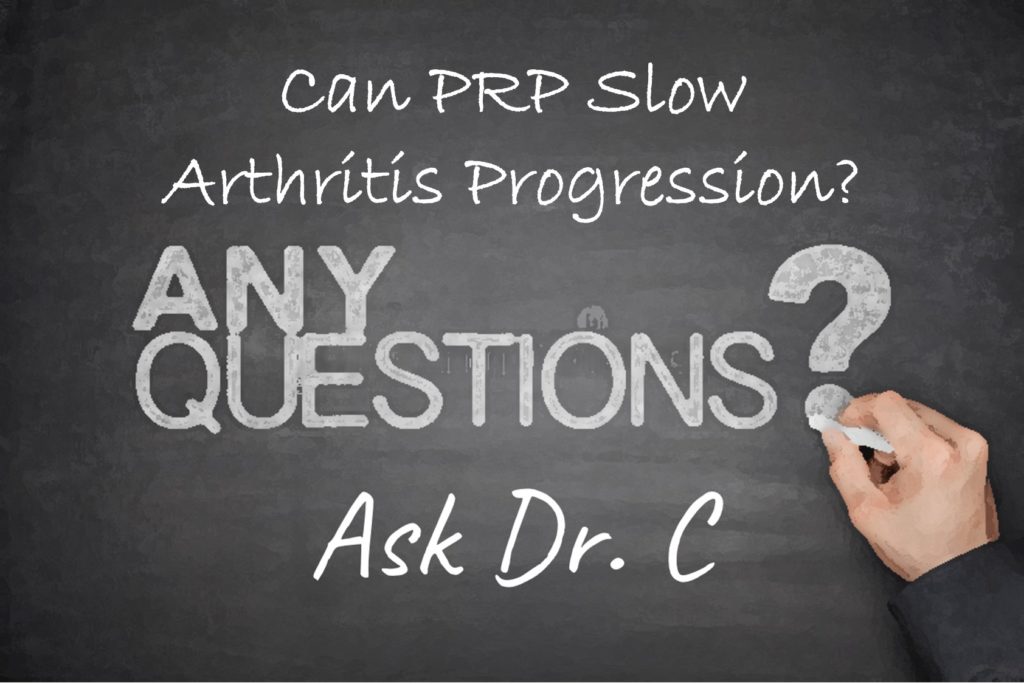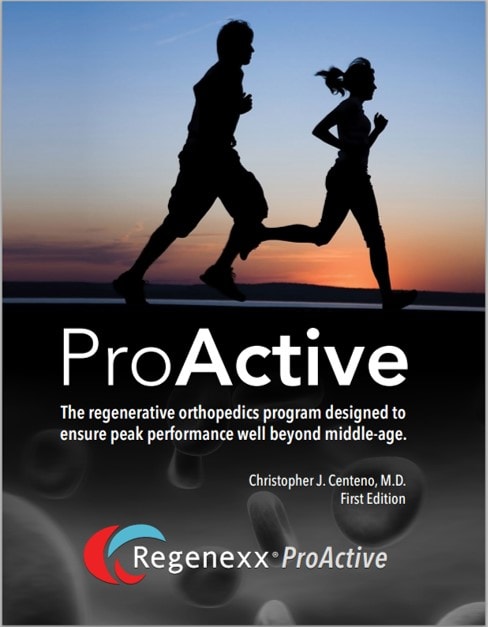Ask Dr. C-Episode 11-Can PRP Reduce Arthritis Progression?

I still have a few more great questions to answer, but this one stood out. Can PRP or stem cells slow the progression of arthritis? Let’s dig in.
Can PRP and/or stem cells prevent further cartilage loss as opposed to regrowing cartilage?
I love this question because the holy grail of osteoarthritis treatment has long been to find a drug that can reduce the slow and steady decline of a knee or other joint once arthritis sets in. Meaning, once you begin to get just a little arthritis, it’s almost a certainty that this will progress year over year to get a bit worse with time. Eventually, the joint slides down that slippery slope enough so that it’s bone on bone. This process happens more quickly in certain joints like the hip and can be slower in joints like the knee. Hence, if there was some drug or orthobiologic you could inject into, let’s say the knee, that would slow or stop this inevitable progression, that would be a game-changer in arthritis care. So is PRP or Bone Marrow Concentrate that game-changer?
I performed a brief literature review this morning of mostly newer studies and here’s what I found. First, realize that this wasn’t meant as an exhaustive review. However, some trends do emerge.
PRP was able to protect rabbit joints from arthritis by reducing the inflammation in the tissues and loss of cartilage matrix (1). In a rat study, PRP was able to avoid cartilage cells from going into apoptosis (preprogrammed cell death) which protected the cartilage from breaking down (2). In comparing PRP alone and Bone Marrow Concentrate (BMC or a same-day stem cell procedure), the BMC showed better cartilage protection than PRP which did better than saline (3).
In a clinical study with MRI tracking over time, despite having knee arthritis, 73% of patients who got PRP didn’t have a progression of their knee arthritis at one year (4). This study didn’t have a control group. In another study with controls, PRP reduced cartilage loss and swelling in the joint tissues (synovitis) at 8 months after injection (5). However, in another study out of Sapin, while PRP beat hyaluronic acid and NSAID drugs for pain and function, there was no difference in arthritis progression between the PRP and HA groups (6). However, it’s important to note that HA in and of itself could have a cartilage protection effect.
So, looking at this data, IMHO it’s more likely than not that PRP does protect most knee joints with arthritis from progressing and losing cartilage. That conclusion could change or be strengthened as more data is published.
What Do I Do For Me?
As an expert in this area, I’ve been seeing this handwriting on the wall for years. Hence, I have my colleagues inject my knees with our high-dose PRP at least once a year. Sometimes that’s because they ache a bit in certain circumstances. Sometimes it’s because I’m getting other things injected and want to top them up from a regeneration standpoint. However, for me, the data is strong enough that this strategy makes sense to me. In fact, it makes so much sense to me that several years ago, I wrote a whole book on the topic:
This is a quick read, but I’d encourage you to dig into it.
The upshot? IMHO, PRP should be used as a way to reduce the progression of knee arthritis. That’s how I use the stuff personally and the published research to date is supporting that idea!
_________________________________
(1) Xue Y, Su X, Jiang M, Yu Z, Yang H, Qin L, Giannoudis PV, Guo JJ. Pure platelet-rich plasma facilitates the repair of damaged cartilage and synovium in a rabbit hemorrhagic arthritis knee model. Arthritis Res Ther. 2020 Apr 5;22(1):68. doi: 10.1186/s13075-020-02155-6. PMID: 32248827; PMCID: PMC7133006.
(2) Asjid R, Faisal T, Qamar K, Khan SA, Khalil A, Zia MS. Platelet-rich Plasma-induced Inhibition of Chondrocyte Apoptosis Directly Affects Cartilage Thickness in Osteoarthritis. Cureus. 2019 Nov 1;11(11):e6050. doi: 10.7759/cureus.6050. PMID: 31827985; PMCID: PMC6890159.
(3) Wang Z, Zhai C, Fei H, Hu J, Cui W, Wang Z, Li Z, Fan W. Intraarticular injection autologous platelet-rich plasma and bone marrow concentrate in a goat osteoarthritis model. J Orthop Res. 2018 Feb 21. doi: 10.1002/jor.23877. Epub ahead of print. PMID: 29464749.
(4) Halpern B, Chaudhury S, Rodeo SA, Hayter C, Bogner E, Potter HG, Nguyen J. Clinical and MRI outcomes after platelet-rich plasma treatment for knee osteoarthritis. Clin J Sport Med. 2013 May;23(3):238-9. doi: 10.1097/JSM.0b013e31827c3846. PMID: 23238250.
(5) Raeissadat SA, Ghorbani E, Sanei Taheri M, Soleimani R, Rayegani SM, Babaee M, Payami S. MRI Changes After Platelet Rich Plasma Injection in Knee Osteoarthritis (Randomized Clinical Trial). J Pain Res. 2020 Jan 10;13:65-73. doi: 10.2147/JPR.S204788. PMID: 32021396; PMCID: PMC6959502.
(6) Buendía-López D, Medina-Quirós M, Fernández-Villacañas Marín MÁ. Clinical and radiographic comparison of a single LP-PRP injection, a single hyaluronic acid injection and daily NSAID administration with a 52-week follow-up: a randomized controlled trial. J Orthop Traumatol. 2018 Aug 20;19(1):3. doi: 10.1186/s10195-018-0501-3. PMID: 30128934; PMCID: PMC6102156.

If you have questions or comments about this blog post, please email us at [email protected]
NOTE: This blog post provides general information to help the reader better understand regenerative medicine, musculoskeletal health, and related subjects. All content provided in this blog, website, or any linked materials, including text, graphics, images, patient profiles, outcomes, and information, are not intended and should not be considered or used as a substitute for medical advice, diagnosis, or treatment. Please always consult with a professional and certified healthcare provider to discuss if a treatment is right for you.

